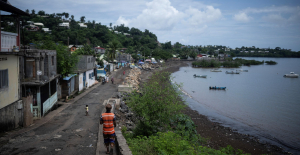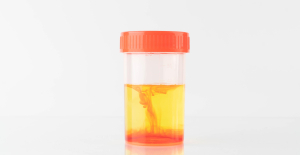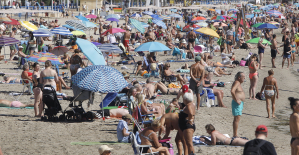cocos (keeling) islands is a tropical small group of islands comprised of two atolls with a total of 27 coral islands about halfway between Australia and Sri Lanka in the Indian ocean.
the Islands, which are australian soil, is located where several ocean currents come together, but outside of the largest southeast asian waterways.
Now researchers have been able to observe that these small landskärvor with less than 600 inhabitants, is home to almost a million discarded shoes and 373.000 end-of-life toothbrushes.
in Total, there are 414 million waste items with a combined weight of 238 tons on the islands. A quarter is plastic. Over 90 percent of the garbage is not visible because they are hidden a foot under the surface.
the permanent residents it would take around 4,000 years to produce so much waste.
Skräpanalysen is made in a new study published in the scientific journal Scientific Reports.
cocos (keeling) islands as isolated islands, as these work well as a gauge of how polluted the oceans are: There are few local sources of pollution and little human influence, such as no strandbesökare and therefore no regular cleaning of the beaches.
The australian research team made their estimates after having collected the debris in selected areas of 7 of the 27 islands (corresponding to close to 90 percent of the archipelago's landmass) in 2017.
Plastskräpet in the oceans is one of the world's more troublesome environmental problems, because no one knows how it already ended up there to be able to be removed in any effective way. In addition, the broken plastic down extremely slowly. What happens over time is that it is atomized to very small particles.
in order to try to ”vacuum” the seas of plastic, for example, ”The Ocean cleanup”, but it is unclear how much the problem can be mitigated with current technology.
About 40 percent of all the plastics produced will be waste in the same year as it is produced.
Half of all plastic manufactured in the last 60 years have been manufactured since 2005.
throughout The world's oceans, it is estimated now to be 5.250 billion plastic items (most very small). It means that there are more pieces of plastic in the oceans than stars in the Milky way. It may not be a useful reference for all, but it can in any event establish that it relates to astronomical amounts.
Read more: the World's deepest garbage bag found in the Pacific ocean
Read more: Bacteria can eat the islands of plastic waste

 Gaza: under the spotlight, the Israeli-Palestinian conflict shakes up the Eurovision contest
Gaza: under the spotlight, the Israeli-Palestinian conflict shakes up the Eurovision contest Black soldier killed by a police officer in the United States: the sheriff publishes the video of the arrest
Black soldier killed by a police officer in the United States: the sheriff publishes the video of the arrest In Malmö, the Eurovision party transformed into entrenched camps
In Malmö, the Eurovision party transformed into entrenched camps In Russia, Vladimir Putin stigmatizes “Western elites”
In Russia, Vladimir Putin stigmatizes “Western elites” Fatal case of cholera in Mayotte: the epidemic is “contained”, assures the government
Fatal case of cholera in Mayotte: the epidemic is “contained”, assures the government The presence of blood in the urine, a warning sign of bladder cancer
The presence of blood in the urine, a warning sign of bladder cancer A baby whose mother smoked during pregnancy will age more quickly
A baby whose mother smoked during pregnancy will age more quickly The euro zone economy grows in April at its best pace in almost a year but inflationary pressure increases
The euro zone economy grows in April at its best pace in almost a year but inflationary pressure increases Artificial intelligence lies, cheats and deceives us, and that's a problem, experts warn
Artificial intelligence lies, cheats and deceives us, and that's a problem, experts warn Google Cloud mistakenly deletes UniSuper fund account and deprives 600,000 Australians of their superannuation
Google Cloud mistakenly deletes UniSuper fund account and deprives 600,000 Australians of their superannuation IBM, Amazon, Hager... These record investments expected at the Choose France summit
IBM, Amazon, Hager... These record investments expected at the Choose France summit Boeing's black streak: a second Air France flight diverted in three days for “a smell of heat”
Boeing's black streak: a second Air France flight diverted in three days for “a smell of heat” “I want to apologize”: Kendji Girac speaks for the first time since his injury
“I want to apologize”: Kendji Girac speaks for the first time since his injury Gollum at the heart of the next Lord of the Rings film and controversies
Gollum at the heart of the next Lord of the Rings film and controversies In Paris, the redevelopment of the squares between Bastille and the Saint-Martin canal displeases some residents
In Paris, the redevelopment of the squares between Bastille and the Saint-Martin canal displeases some residents Cate Blanchett in majesty at the San Sebastian Festival
Cate Blanchett in majesty at the San Sebastian Festival Omoda 7, another Chinese car that could be manufactured in Spain
Omoda 7, another Chinese car that could be manufactured in Spain BYD chooses CA Auto Bank as financial partner in Spain
BYD chooses CA Auto Bank as financial partner in Spain Tesla and Baidu sign key agreement to boost development of autonomous driving
Tesla and Baidu sign key agreement to boost development of autonomous driving Skoda Kodiaq 2024: a 'beast' plug-in hybrid SUV
Skoda Kodiaq 2024: a 'beast' plug-in hybrid SUV The home mortgage firm rises 3.8% in February and the average interest moderates to 3.33%
The home mortgage firm rises 3.8% in February and the average interest moderates to 3.33% This is how housing prices have changed in Spain in the last decade
This is how housing prices have changed in Spain in the last decade The home mortgage firm drops 10% in January and interest soars to 3.46%
The home mortgage firm drops 10% in January and interest soars to 3.46% The jewel of the Rocío de Nagüeles urbanization: a dream villa in Marbella
The jewel of the Rocío de Nagüeles urbanization: a dream villa in Marbella Diving into the secrets of the National Assembly
Diving into the secrets of the National Assembly Institutions: senators want to restore the accumulation of mandates and put an end to the automatic presence of ex-presidents on the Constitutional Council
Institutions: senators want to restore the accumulation of mandates and put an end to the automatic presence of ex-presidents on the Constitutional Council Europeans: David Lisnard expresses his “essential and vital” support for François-Xavier Bellamy
Europeans: David Lisnard expresses his “essential and vital” support for François-Xavier Bellamy Facing Jordan Bardella, the popularity match turns to Gabriel Attal’s advantage
Facing Jordan Bardella, the popularity match turns to Gabriel Attal’s advantage These French cities that will boycott the World Cup in Qatar
These French cities that will boycott the World Cup in Qatar Tennis: Djokovic knocked out by a gourd after his match in Rome (on video)
Tennis: Djokovic knocked out by a gourd after his match in Rome (on video) Handball: the Blues gently begin their Olympic preparation against the United States
Handball: the Blues gently begin their Olympic preparation against the United States WRC: Rovanperä leads the Rallye du Portugal ahead of Ogier
WRC: Rovanperä leads the Rallye du Portugal ahead of Ogier Ligue 2: Auxerre validates its return to Ligue 1 after a draw in Amiens
Ligue 2: Auxerre validates its return to Ligue 1 after a draw in Amiens


















